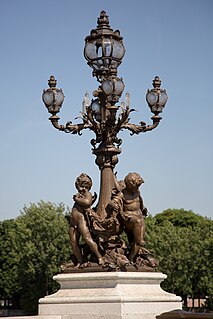
A street light, light pole, lamppost, street lamp, light standard, or lamp standard is a raised source of light on the edge of a road or path. Similar lights may be found on a railway platform. When urban electric power distribution became ubiquitous in developed countries in the 20th century, lights for urban streets followed, or sometimes led.

The Theodore Roosevelt Bridge is a bridge crossing the Potomac River which connects Washington, D.C., with the Commonwealth of Virginia. The bridge crosses over Theodore Roosevelt Island, and carries Interstate 66/U.S. Route 50. The center lane in the bridge is reversible; the middle barrier is moved with a barrier transfer machine. It's operated eastbound during the morning rush hour from 6-11 am. The bridge is named in honor of Theodore Roosevelt, the 26th President of the United States.
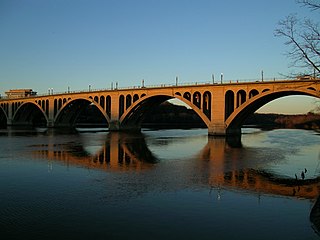
The Francis Scott Key Bridge, more commonly known as the Key Bridge, is a six-lane reinforced concrete arch bridge conveying U.S. Route 29 (US 29) traffic across the Potomac River between the Rosslyn neighborhood of Arlington County, Virginia, and the Georgetown neighborhood of Washington, D.C. Completed in 1923, it is Washington's oldest surviving road bridge across the Potomac River.
Constitution Avenue is a major east–west street in the northwest and northeast quadrants of the city of Washington, D.C., in the United States. It was originally known as B Street, and its western section was greatly lengthened and widened between 1925 and 1933. It received its current name on February 26, 1931, though it was almost named Jefferson Avenue in honor of Thomas Jefferson. Constitution Avenue's western half defines the northern border of the National Mall and extends from the United States Capitol to the Theodore Roosevelt Bridge. Its eastern half runs through the neighborhoods of Capitol Hill and Kingman Park before it terminates at Robert F. Kennedy Memorial Stadium. Many federal departmental headquarters, memorials, and museums line Constitution Avenue's western segment.
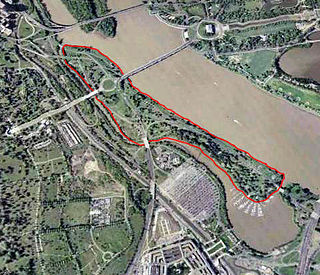
Lady Bird Johnson Park, formerly known as Columbia Island until 1968, is an island located in the Potomac River in Washington, D.C., in the United States. It formed naturally as an extension of Analostan Island in the latter part of the 1800s, and over time erosion and flooding severed it from Analostan, now known as Theodore Roosevelt Island. The U.S. federal government deposited material dredged from the Potomac River on the island between 1911 and 1922, and again from 1925 to 1927. The island was also reshaped by the government at this time "to serve as the western terminus of Arlington Memorial Bridge and a symbolic entrance into the nation’s capital." Located within the park are the Lyndon Baines Johnson Memorial Grove, Navy – Merchant Marine Memorial, and the Columbia Island Marina. The island, park, memorials, and marina are part of the George Washington Memorial Parkway and administered by the National Park Service.

The Frederick Douglass Memorial Bridge is a through arch bridge that carries South Capitol Street over the Anacostia River in Washington, D.C. It was completed in 2021 and replaced an older swing bridge that was completed in 1950 as the South Capitol Street Bridge. In 1965, the original bridge was renamed after abolitionist Frederick Douglass. In 2007, the original swing bridge was used by 77,000 daily commuters.

The Taft Bridge is a historic bridge located in the Northwest quadrant of Washington, D.C. It carries Connecticut Avenue over the Rock Creek gorge, including Rock Creek and the Rock Creek and Potomac Parkway, connecting the neighborhoods of Woodley Park and Kalorama. It is named after former United States president and Supreme Court Chief Justice William Howard Taft, and sits to the southwest of the Duke Ellington Bridge.
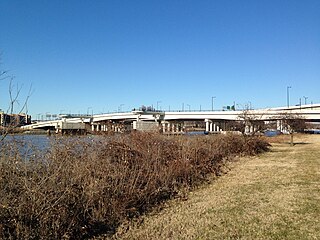
The 11th Street Bridges are a complex of three bridges across the Anacostia River in Washington, D.C., United States. The bridges convey Interstate 695 across the Anacostia to its southern terminus at Interstate 295 and DC 295. The bridges also connect the neighborhood of Anacostia with the rest of the city of Washington.

The DC Circulator is a bus system in Washington, D.C. The District of Columbia Department of Transportation operates the service in a public-private partnership with RATP Dev.

Thomas Circle is a traffic circle in Northwest Washington, D.C., in the United States. It is located at the intersection of Massachusetts Avenue NW, Vermont Avenue NW, 14th Street NW, and M Street NW. It is named for George Henry Thomas, a Union Army general in the American Civil War.

Ohio Drive is a street in Southwest Washington, D.C., located in East and West Potomac Parks and bordering the Tidal Basin, Washington Channel, and the Potomac River. It is a central organizing feature of East Potomac Park, providing the only major vehicular route to and through the area. Unlike most roadways named after states in the District of Columbia, Ohio Drive is not an avenue, nor it is heavily used like Wisconsin or Rhode Island Avenues. However, the segment from Independence Avenue to the Rock Creek and Potomac Parkway is an important commuter route.

Barney Circle is a small residential neighborhood located between the west bank of the Anacostia River and the eastern edge of Capitol Hill in southeast Washington, D.C., in the United States. The neighborhood is characterized by its sense of community, activism, walkability, and historic feel. The neighborhood's name derives from the eponymous former traffic circle Pennsylvania Avenue SE just before it crosses the John Philip Sousa Bridge over the Anacostia. The traffic circle is named for Commodore Joshua Barney, Commander of the Chesapeake Bay Flotilla in the War of 1812.

The District Department of Transportation is an agency of the government of the District of Columbia, in the United States, which manages and maintains publicly owned transportation infrastructure in the District of Columbia. DDOT is the lead agency with authority over the planning, design, construction, and maintenance of alleys, bridges, sidewalks, streets, street lights, and traffic signals in the District of Columbia.

Martin Luther King Jr. Avenue is a major street in the District of Columbia traversing through both the Southwest and Southeast quadrants.

The American Veterans Disabled for Life Memorial is a memorial in Washington, D.C., which honors veterans of the armed forces of the United States who were permanently disabled during the course of their national service. Congress adopted legislation establishing the memorial on October 23, 2000, authorizing the Disabled Veterans for Life Memorial Foundation to design, raise funds for, and construct the memorial. The fundraising goal was reached in mid-2010, and ground for the memorial broken on November 10, 2010. The memorial was dedicated by President Barack Obama on October 5, 2014.

The James V. Forrestal Building is a low-rise Brutalist office building located in Washington, D.C., in the United States. Originally known as Federal Office Building 5, and nicknamed the Little Pentagon, the Forrestal Building was constructed between 1965 and 1969 to accommodate United States armed forces personnel. It is named after James Forrestal, the first United States Secretary of Defense. It became the headquarters of the United States Department of Energy after that agency's creation in 1977.

The construction of Arlington Memorial Bridge was a seven-year construction project in Washington, D.C., in the United States to construct the Arlington Memorial Bridge across the Potomac River. The bridge was authorized by Congress in February 1925, and was completed in January 1932. As a memorial, its decorative features were extensive and intricate, and resolving the design issues over these details took many years. Tall columns and pylons topped by statuary, Greek Revival temple-like structures, and statue groups were proposed for the ends of the bridge. Carvings and inscriptions were planned for the sides of the bridge, and extensive statuary for the bridge piers.
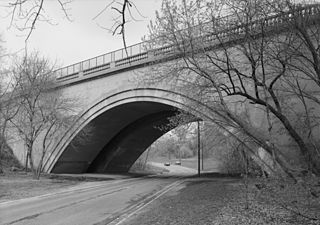
The 16th Street Bridge, also known as the Piney Branch Bridge, is an automobile and pedestrian bridge that carries 16th Street NW over Piney Branch and Piney Branch Parkway in Washington, D.C. It was the first parabolic arch bridge in the United States. Construction on the first span began in 1905 as part of the northward extension of 16th Street, and was finished in 1907 but was never opened to traffic. The second span began construction in 1909 and was completed in 1910. The bridge was renovated in 1990, and again beginning in October 2014.

The H Street/Benning Road Line is a currently operating line of DC Streetcar. It has eight stations and began operation on February 27, 2016. The 2.4-mile (3.9 km) line runs along H Street NE and Benning Road NE in Washington, D.C. In September 2016 service was increased from six days a week to seven, and with shorter 12-minute headways.
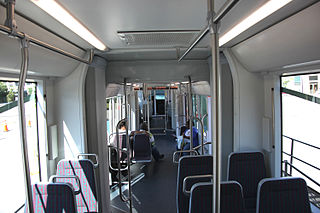
The Anacostia Line is a partially constructed line of the DC Streetcar, never put into service, intended to connect the Anacostia neighborhood with Joint Base Anacostia–Bolling. Construction occurred in 2009 and 2010, but was terminated before the line was complete.




















